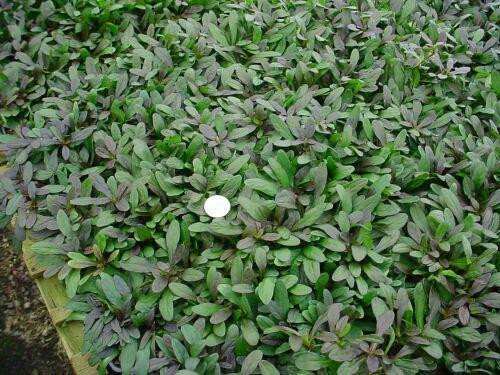Product Description
Ajuga "Chocolate Chip" (4) 1-gallons
a/k/a Carpenters Herb, Comfrey, Creeping Bugleweed,
Creeping Carpet Bugle, Sicklewort
Zone 4 to 9, maybe 3 to 10,
Sun to full shade, at least 3 to 4 hours of sun for best foliage color.
Mature foliage height 3 to 4 inch; dwarf habit spreading groundcover.
Ajuga 'Chocolate Chip' is a delightful little groundcover plant that offers a unique combination of color, texture, and versatility. Here is what makes it a great addition to gardens:
Distinctive Appearance:
- Compact Size: 'Chocolate Chip' is a dwarf variety of Ajuga, typically growing only 2-3 inches tall and spreading 6-9 inches wide. This makes it perfect for small spaces or tucking into nooks and crannies.
- Rich Chocolate Foliage: The most striking feature of 'Chocolate Chip' is its foliage. The leaves are small, narrow, and a deep chocolate-brown color with hints of burgundy. This rich color adds depth and interest to shady areas where other plants might struggle.
- Blue Flower Spikes: In late spring to early summer, 'Chocolate Chip' sends up short spikes of blue flowers. These blooms add a lovely contrast to the dark foliage and attract pollinators like bees and butterflies.
Growing Conditions:
- Shade Tolerance: 'Chocolate Chip' thrives in partial to full shade. It is an excellent choice for brightening up those dark corners of the garden where other plants might not perform well.
- Adaptable to Soil: It can tolerate a variety of soil types, including clay, loam, and sand, as long as they are well-drained.
- Moist Soil: While it prefers moist soil, it can tolerate some dryness once established.
Care and Maintenance:
- Low Maintenance: 'Chocolate Chip' is a very low-maintenance plant. Once established, it requires minimal care.
- Watering: Water regularly during the first year to help it establish its roots. After that, it can tolerate some dryness.
- Fertilizing: Generally, it does not require regular fertilization, but a light feeding in spring can be beneficial.
- Controlling Spread: 'Chocolate Chip' can spread aggressively, so you may need to control its growth by dividing it every few years or removing unwanted runners.
Uses in the Garden:
- Groundcover: Its spreading habit makes it an excellent groundcover for shady areas. It can help suppress weeds and prevent soil erosion.
- Edging: It can be used to edge pathways, borders, or garden beds, adding a neat and tidy border.
- Rock Gardens: It is also well-suited for rock gardens, where it can fill in spaces between stones and add texture and interest.
- Containers: It can be grown in containers, adding a touch of color and texture to patios or balconies.
- Underplanting: 'Chocolate Chip' is a great choice for underplanting larger shrubs or trees, as it can tolerate some shade and competition.
Benefits:
- Shade Tolerance: Its ability to thrive in shade makes it a valuable plant for brightening up dark areas of the garden.
- Low-Maintenance: Its minimal care requirements make it an ideal plant for busy gardeners.
- Deer and Rabbit Resistant: Deer and rabbits tend to avoid Ajuga, so it is a good choice for gardens where these animals are a problem.
- Attractive Foliage: The rich chocolate-brown foliage provides year-round interest, even when the plant is not in bloom.
If you are looking for a tough, beautiful, and low-maintenance groundcover to add to your garden, Ajuga 'Chocolate Chip' is an excellent choice! Its unique foliage, blue flowers, and adaptability make it a valuable addition to any landscape.
(4) 1-gallon containers ready to plant, plants may be trimmed for shipping,
Other Details
The most important part of the plant is its root system. Healthy roots are the foundation of a healthy, vibrant plant. The type of plug container used is based on the specific needs of the plants. Perennials offered as bare root traditionally perform better when planted as bare root.Planted in a specialized mix, potted plants have well established root systems. Top growth stage will vary depending on the current life cycle and time of year when shipped. In Winter and early Spring dormant plants may be shipped. Dormant plants may be planted right away, even before the last frost date.
Most bare root varieties are field grown for at least one season, though Hemerocallis and Hosta are grown for two seasons. The bulk of the soil is removed during the harvesting process and the tops of most varieties are trimmed back to the crown. They are graded, packed in shredded aspen or sphagnum moss and stored in freezers until ready to be shipped.
See our Container Sizes and Bare Root Perennials pages for more information.
Plant information and care is provided in the Overview section, Plant Genus Page and general information is provided in the Planting Care & Guides. Additional questions can be asked on each Plant page.
Plant Spacing: Using the maximum mature spread or width of a plant to guide spacing, ensures space to grow to full size. To fill an area sooner, plant them closer together. Just remember, future thinning or transplanting may be needed.
Water: Keep a close eye on newly planted perennials, especially throughout the first growing year. Most early plant loss is due to too much or too little water!























